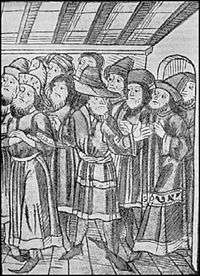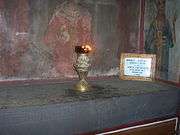Alexander I of Moldavia
.jpg)

Alexander the Good (Romanian: Alexandru cel Bun pronounced [alekˈsandru t͡ʃel bun] or Alexandru I Mușat) was a Voivode (Prince) of Moldavia, reigning between 1400 and 1432,[1] son of Roman I Mușat. He succeeded Iuga to the throne,[2] and, as a ruler, initiated a series of reforms while consolidating the status of the Moldavian Principality.
Internal politics

Alexander expanded the bureaucratical system by creating the "Council of the Voivode", the Chancellory and by adding (in 1403) the institution of Logofăt – Chancellor of the official Chancellery.
During his reign, he introduced new fiscal laws, by adding commercial privileges to the traders of Lviv (1408) and Kraków (1409), improved the situation of the trading routes (especially the one linking the port of Cetatea Albă to Poland), strengthened the forts guarding them, and expanded the Moldavian ports of Cetatea Albă and Chilia.
He also had a role in ending the conflict of the Moldavian Eastern Orthodox with the Patriarch of Constantinople; he built Bistrița Monastery where he is buried and continued the building of Neamț Monastery which was started in the previous century.
Foreign affairs
The main concern of Alexander the Good was to defend the country in wars against superior armies. In order to do that, he forged a system of alliances with Wallachia and Poland, generally against Hungary (although he had been backed to the throne by Sigismund of Hungary). In 1402, he was sworn vassal of Jogaila, the King of Poland.[3] The treaty was renewed in 1404, 1407, 1411 and 1415.
Alexander participated in two battles against the Teutonic Knights: in 1410 at Grunwald and in 1422 at Marienburg. In 1420, he also defended Moldavia against the first incursion by Ottomans at Cetatea Albă. He also got involved in the power struggles of Wallachia, by helping Radu II Prasnaglava in 1418–1419 and Alexandru I Aldea in 1429, mostly in order to prevent the capture of Chilia.
Due to a territorial claim of Poland and the previous failure of the Polish king to fulfill his part of the vassality treaty during an Ottoman attack in 1420, Alexander launched an attack on Poland during the Lithuanian Civil War (1431–1435). The attack ended with the treaty of Suceava on November 18, 1431.
Slavery
Alexander makes the first documentary confirmation of the gypsy slavery in Moldova, giving the monastery of Bistrița 31 gypsy families along with some cattle.[4]:14
Personal life

Alexandru cel Bun had four legitimate wives – Margareta Loszonc, Ana Neacşa, Rymgajla (daughter of Kęstutis and sister of Vytautas the Great of Lithuania; divorced in 1421), and Mariana. His sons later reigning in Moldavia - Iliaș, Stephen II, Petru II, Bogdan II (father of Stephen the Great) and Alexander.[5] He was father-in-law to Vlad II Dracul and grandfather to Vlad III the Impaler through his eldest daughter, Cneajna (or Vasilisa, or Maria Muşat).
He died on January 1, 1432, and was buried in the Bistriţa Monastery.
See also
| Ancestors of Alexander I of Moldavia | |||||||||||||||||||||||||||||||||||||||||||||||||||||||||||||||||||||||||||||||||||||||||||||||||||||||||||||||||||||||||||||||||||||
|---|---|---|---|---|---|---|---|---|---|---|---|---|---|---|---|---|---|---|---|---|---|---|---|---|---|---|---|---|---|---|---|---|---|---|---|---|---|---|---|---|---|---|---|---|---|---|---|---|---|---|---|---|---|---|---|---|---|---|---|---|---|---|---|---|---|---|---|---|---|---|---|---|---|---|---|---|---|---|---|---|---|---|---|---|---|---|---|---|---|---|---|---|---|---|---|---|---|---|---|---|---|---|---|---|---|---|---|---|---|---|---|---|---|---|---|---|---|---|---|---|---|---|---|---|---|---|---|---|---|---|---|---|---|
| |||||||||||||||||||||||||||||||||||||||||||||||||||||||||||||||||||||||||||||||||||||||||||||||||||||||||||||||||||||||||||||||||||||
Notes
- ↑ Vauchez, Andre (2001-04-01). Encyclopedia of the Middle Ages. Routledge. ISBN 1-57958-282-6.
- ↑ Williams, Henry Smith (1909). The Historians' History of the World. Hooper & Jackson. p. 242. ISBN 0-8419-0088-4.
- ↑ King, Charles H. (2000). The Moldovans: Romania, Russia, and the politics of culture. Stanford, CA: Hoover Institution Press. p. 15. ISBN 0-8179-9791-1.
- ↑ Achim, Viorel (2004). The Roma in Romanian History. Central European University Press. ISBN 963-9241-84-9.
- ↑ http://enciclopediaromaniei.ro/wiki/Alexandru_cel_Bun
External links
- Marek, Miroslav. "Muşatin family". Genealogy.EU.
| Preceded by Iuga |
Prince/Voivode of Moldavia 1400–1432 |
Succeeded by Iliaş |